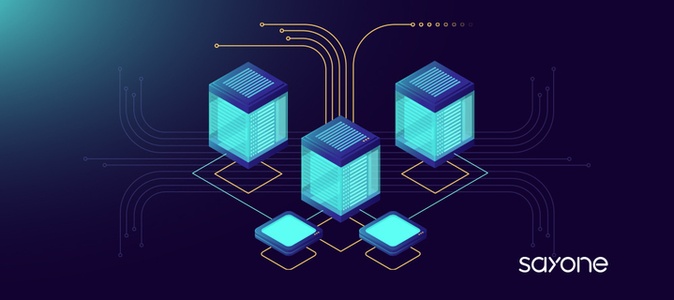Java Microservices Architecture - A Complete Guide 2023

Share This Article
Syntax and Language Structure: A Comparison of Python and JavaScript
Table of Contents
Subscribe to Our Blog
We're committed to your privacy. SayOne uses the information you provide to us to contact you about our relevant content, products, and services. check out our privacy policy.
Microservices architecture is a modern approach to building software applications that emphasizes breaking down complex systems into smaller, independent services. These services, known as microservices, are self-contained and communicate with each other through APIs.
What are Microservices?
Microservices are small, ‘autonomous’ services that work together to form a complete application. Each microservice focuses on a specific business capability and can be developed, deployed, and scaled independently. This modular approach allows for greater flexibility, easier maintenance, and faster development cycles.
Advantages of Microservices Architecture
- Scalability: Microservices can be independently scaled, enabling efficient resource utilization and better handling of varying workloads.
- Flexibility: Developers can use different programming languages and technologies for different microservices based on specific requirements.
- Continuous Deployment: Each microservice can be updated and deployed independently, reducing downtime and ensuring faster delivery of new features.
- Fault Isolation: If one microservice fails, the entire application does not collapse, as other services can continue functioning.
- Team Autonomy: Development teams can work on specific microservices, promoting faster development and innovation.
Java and Microservices: A Winning Combination
Java is a popular choice for building microservices due to its robustness, platform independence, and extensive ecosystem of libraries and frameworks. Its object-oriented nature and scalability make it well-suited for creating ‘modular’ and ‘distributed applications.’
Checkout the detailed guide on Advantages and Disadvantages of Microservices Architecture
By adopting Java for microservices, developers can use its mature tooling, strong community support, and proven reliability. Java's compatibility with cloud-based technologies and containerization further improves the development and deployment process.
Fundamental Principles and Design Patterns
Understanding key principles and design patterns is crucial for a successful and efficient development process when developing a web application using ‘Java Microservices architecture.
Let's explore some essential principles and patterns that can greatly benefit your microservices journey:
1. Single Responsibility Principle (SRP)
The ‘Single Responsibility Principle’ is the foundation of microservices architecture. It advocates that each microservice should have a single responsibility, focusing on a- specific business capability. By adhering to ‘SRP,’ microservices become more ‘maintainable,’ ‘testable,’ and ‘scalable.’
2. Domain-Driven Design (DDD)
‘Domain-Driven Design’ emphasizes modeling software based on the business domain, ensuring the design aligns with real-world concepts and processes. In a- microservices context, ‘DDD’ helps define each microservice's boundaries and interactions. It promotes a common language across the development team, fostering better communication and understanding between developers and domain experts.
Checkout Microservices Architecture & the most important design Patterns
3. Communication Protocols: REST and Messaging
Effective communication between microservices is vital for a flawless system. ‘REST’ (Representational State Transfer) is widely used for synchronous communication, providing a standard way to expose APIs. On the other hand, ‘messaging’ (asynchronous communication) facilitates decoupling between microservices and event-driven architectures, which improves scalability and responsiveness.
4. Data Management Strategies
Microservices need to handle data efficiently. Choosing appropriate data management strategies, such as database-per-service or event sourcing, can impact the overall performance and maintainability. Each microservice should manage its data independently, ensuring data consistency and reducing dependencies.
5. Fault Tolerance and Resilience
Resilience is a critical aspect of microservices, as failures in one service should not bring down the entire system. Implementing fault tolerance mechanisms like circuit breakers, timeouts, and retries can help microservices handle errors gracefully. By using resilience patterns, you make sure system stability and prevent cascading failures.
Building Java Microservices
- Setting up the Development Environment:
Java microservices development starts with a conducive development environment. Ensure you have the latest version of Java Development Kit (JDK) installed. Choose an Integrated Development Environment (IDE) that suits your workflow, such as ‘Eclipse,’ ‘IntelliJ IDEA,’ or ‘Visual Studio Code.’ These IDEs offer powerful features like code completion, debugging, and project management to streamline your development process.
- Choosing the Right Microservice Framework:
Selecting an appropriate microservice framework is crucial for the success of your project. Popular choices like ‘Spring Boot’ and ‘Micronaut’ offer extensive support for building microservices in Java. With its robust ecosystem, Spring Boot simplifies configuration and provides features like dependency injection and automatic configuration. On the other hand, ‘Micronaut’ offers a lightweight alternative with faster startup times and a reduced memory footprint, making it ideal for cloud-native deployments.
Read more on Building Microservices Application Using Spring Boot & Cloud
- Defining Microservice Boundaries:
Defining boundaries for your microservices is vital to ensure scalability and maintainability. Use ‘Domain-Driven Design’ (DDD) principles to identify individual domains and responsibilities. Break down complex business processes into manageable services that can communicate. This practice enables independent development and scaling of microservices, fostering a more agile development process.
- Containerization with Docker:
Containerization plays a pivotal role in packaging and deploying microservices. The ‘Docker’ provides a standardized way to create, deploy, and run applications in lightweight containers. By containerizing your microservices, you ensure consistent behavior across various environments, reducing compatibility issues. Docker allows you to package each microservice with its dependencies, making it easier to manage and deploy.
- Deploying Microservices on Kubernetes:
As a powerful container orchestration tool, ‘Kubernetes’ facilitates the deployment and management of containerized applications. With Kubernetes, you can scale your microservices dynamically, ensuring high availability and fault tolerance. Its automatic load balancing and self-healing capabilities help the reliability of your Java microservices deployment.
Kubernetes simplifies scaling your application in response to changing user demands.
Communication and Inter-Service Communication
Understanding the various communication mechanisms between services is crucial for an error-free and efficient development process when developing a web application using Java Microservice architecture.
Let's explore four key aspects of communication in Java Microservices:
Synchronous vs Asynchronous Communication
Synchronous Communication:
- Direct request-response mechanism between services.
- Client waits for a response from the server before proceeding.
- Simplifies the development process for simple interactions with low response times.
- Can lead to performance bottlenecks and increased coupling between services.
Asynchronous Communication:
- Event-driven mechanism using message brokers.
- Services exchange messages asynchronously.
- Enables better scalability and fault tolerance.
Service Discovery
In a microservices environment, services are dynamic and distributed across multiple instances and servers. Service discovery mechanisms help locate and connect to these services effectively.
Learn more about Microservices Communication
Key Features:
- Dynamic Service Registration: Services register themselves with a service registry.
- Service Lookup: Clients query the service registry to find available services.
- Load Balancing: Service discovery enables load balancing across instances.
- Popular Tools: Eureka, Consul, ZooKeeper.
API Gateways
API gateways are a single entry point for client requests, providing a unified interface to access multiple microservices.
Functionality:
- Request Routing: Routes incoming requests to the appropriate microservice.
- Load Balancing: Distributes client requests across service instances.
- Protocol Translation: Translates client requests into the appropriate protocol for each service.
- Authentication and Security: Implements authentication and authorization mechanisms.
- Common Choices: Netflix Zuul, Spring Cloud Gateway.
Event-Driven Architecture
Event-driven architecture is based on the exchange of events among services, allowing loosely-coupled interactions.
Key Elements:
- Events: Represent significant occurrences in the system.
- Event Brokers: Facilitate the communication of events to multiple services.
- Decoupled Services: Services react to events without direct dependencies.
- Popular Event Brokers: Apache Kafka, RabbitMQ.
Sample Code Example (Publishing an Event with Kafka):
Monitoring and Scaling Java Microservices
Effective monitoring and scaling strategies play a pivotal role in ensuring smooth operation and optimal performance when developing a web application using Java Microservice architecture.
Here are four essential aspects to consider:
Logging and Tracing
Logging: Implementing logging in microservices helps capture valuable information about system behavior, errors, and user activities. It aids in troubleshooting issues and monitoring application health.
Read more on Do microservices require API Gateways?
Tracing: ‘Distributed tracing’ allows developers to track the flow of requests across microservices. It helps identify performance bottlenecks and ensures communication between services.
Metrics and Health Checks
Metrics: Gathering essential metrics, such as response times, throughput, and error rates, allows developers to gain insights into the performance and health of microservices.
Health Checks: Implementing health checks enables the system to evaluate the operational status of each microservice. It facilitates early detection of failures and improves system resilience.
Scaling Strategies for Microservices
Horizontal Scaling: Microservices can be horizontally scaled by adding more instances to handle the increased load. It ensures load distribution and improves fault tolerance.
Vertical Scaling: Increasing the resources (e.g., CPU, memory) of a single instance can effectively scale microservices. However, it has limitations compared to horizontal scaling.
Load Balancing and Auto-Scaling
Load Balancing: Load balancing distributes incoming requests across multiple instances, ensuring optimal resource utilization and preventing overload on specific microservices.
Read more on Scaling Microservices – A Basic Guide
Auto-Scaling: Automated scaling enables microservices to adapt to varying traffic- loads. It automatically adds or removes instances based on predefined thresholds, maintaining performance and cost efficiency.
By adopting monitoring and scaling practices, developers can confidently deploy Java Microservices that offer high availability, fault tolerance, and excellent user experiences. These strategies greatly benefit the development process, ensuring a reliable and scalable web application architecture.
Security in Java Microservices
When developing a web application using Java Microservice architecture, ensuring the security of your microservices is paramount. Here are three key aspects of security that you should focus on:
Authentication and Authorization
Authentication: Verifying the identity of users or services accessing your microservices is crucial. Implementing authentication mechanisms like ‘OAuth,’ ‘JWT (JSON Web Tokens),’ or ‘API keys’ helps ensure that only authorized users can interact with your microservices.
Authorization: Once a user or service is authenticated, controlling their access to different resources and functionalities is essential. ‘Role-based access control’ (RBAC) or ‘attribute-based access control’ (ABAC) can be employed to enforce appropriate authorization policies.
Securing Communication Channels
Secure Socket Layer (SSL)/Transport Layer Security (TLS): Use ‘SSL/TLS’ to encrypt data transmitted between microservices over the network. This ensures that sensitive information remains confidential and protected from unauthorized access or interception.
API Gateway Security: Secure the communication between clients and microservices by routing requests through an API gateway. The ‘API gateway’ can handle authentication, request validation, and encryption, thereby offloading security concerns from individual services.
Handling Vulnerabilities and Threats
Regular Security Audits: Conduct periodic security audits and code reviews to identify potential vulnerabilities in your microservices. Stay informed about the latest security threats and best practices to safeguard against emerging risks.
Input Validation: Implement strict input validation to prevent injection attacks and data manipulation. Validate and sanitize all user inputs to ensure they meet expected criteria.
Error Handling and Logging: Proper error handling and logging are crucial for identifying and mitigating security issues. Avoid exposing sensitive information in error messages that could aid attackers.
Summary
Understanding the principles of microservices, communication patterns, and security measures is essential for successful implementation. By embracing this architecture, developers can wield its benefits, such as improved modularity, easier maintenance, and faster development cycles. As technology evolves, staying up-to-date with the latest tools and best practices will ensure the seamless integration of Java Microservices for future applications. With SayOne Tech's expertise in Microservices development, you can unlock the full potential of this architecture for your business.
Contact SayOne Tech developers today for top-notch Microservices development services.
Share This Article
Subscribe to Our Blog
We're committed to your privacy. SayOne uses the information you provide to us to contact you about our relevant content, products, and services. check out our privacy policy.
Related Articles

Microservice Architecture
A Complete Guide For Microservices Vs. Monolithic Architectures

